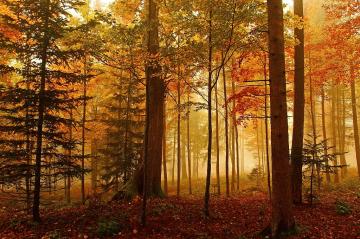Rakuyouju
Well into autumn, yellow and red leaves of trees scatter in the wind. Rakuyouju, deciduous trees, are trees or shrubs that lose their leaves when the temperature becomes low or dryness lasts for a while in autumn, and put forth buds in spring. Deciduous trees come into bud in spring, bring green shades of leaves in summer, and in winter, between their branches deliver warm sunshine to the ground. The characteristics of deciduous trees play important roles in forest ecosystems.
In forests, living things such as trees, flowers, grasses, mosses, animals, birds, bugs and microbes co-exist and all the living things interrelate in the food web. Fallen leaves and branches are decomposed by diverse microbes and become humus soils. Then, the humus soils are used by plants as nutrients. Forests can be sustained using the functions of the ecosystem.
In Japan, representative temperate deciduous trees are beech trees that bear brilliant aspects seasonally. However, Japanese forests are close to the sphere of human habitation, and old growth forests are not many. Among them, the Shiragami mountainous land located between Aomori Prefecture and Akita Prefecture is known as a precious area where old growth beech forests are preserved in pristine condition on a global scale. This area was registered as a UNESCO World Heritage Site (natural heritage site) for the first time in Japan, in 1993.
In recent years, “symbiotic housing” has been promoted by local authorities, public corporations and the private sector in order to deal with emerging environmental problems including global warming, the production of waste and exhaustion of resources, and the loss of regional landscapes and ecosystems. Symbiotic housing is an effort to organize housing and the environment in ways that can effectively and sustainably use the blessings of nature including sunlight, winds, water and greenery. For example, the planting of deciduous trees on the south side and evergreen trees on the north side of a house is also useful. This method of tree planting enables the weakening of strong sunlight and brings fresh winds in summer through the lush green leaves of the deciduous trees. In winter, it delivers warm sunshine to the rooms through the branches of the deciduous trees and weakens north winds through the evergreen trees. This is a system using natural energy that is contributing to save energy in daily life.
Deciduous trees have been planted in many gardens of Japanese houses. There is a variety of deciduous trees: some are flowering and others are fruit bearing. Shapes of the leaves are also unique. Beautiful deciduous trees such as Kousa dogwoods (Benthamidia japonica), Himesyara (Stewartia monadelpha), flowering dogwoods (Cornus florida) and Japanese maples (Acer palmatum) are very popular and beloved as they help us sense the transience of the four seasons.
(Yuri Hoshiba)











